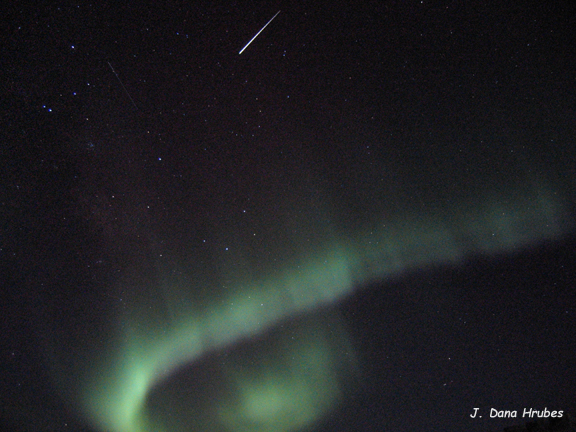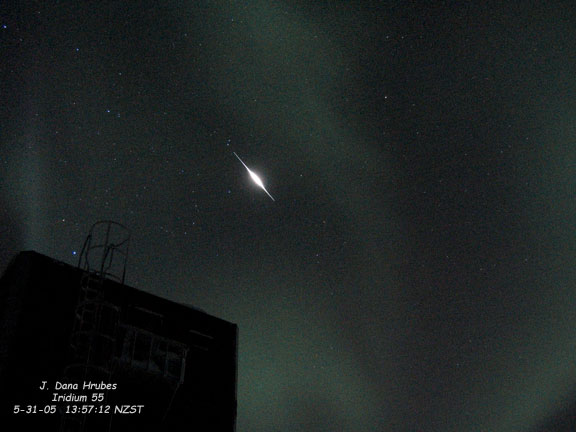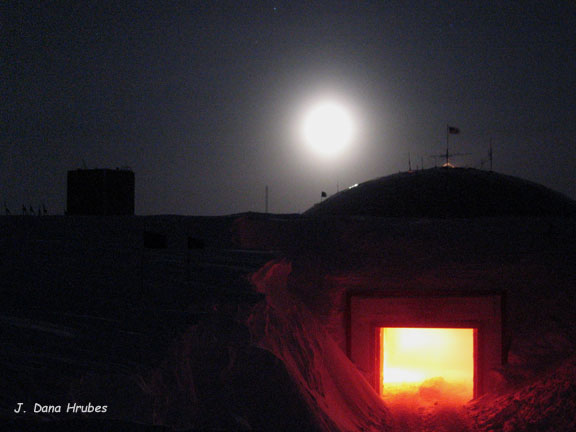
During an aurora an Iridium satellite flares as it reflects sun from one of its antennas

During
an aurora an Iridium satellite flares as it reflects sun from one of
its
antennas
May at the Pole - darkness,
stars, auroras, satellites
May is
the first full month of darkness. At
the South Pole Station Space Sciences Laboratory (formerly the South
Pole Cusp
and Cosray Labs) it is an exciting time of the year. The laboratory is
made up
of a combination of projects investigating the physics of the Earth's
upper
atmosphere and the effects of solar-terrestrial interaction. From
numerous
antennas, magnetometers and other sensors as far as a mile off station,
we
measure fluctuations in the magnetic field of the earth,
electromagnetic waves
from extremely low frequency (ELF) through high frequency (HF), cosmic
rays
from our sun and galactic sources, and cosmic radio noise absorption in
the
upper atmosphere. These measurements are all influenced by solar events
and fluctuations
in the solar wind. This time of the year, however, when the sun is
below the
horizon for six months, we are able to also experience one of visually
awesome
effects of solar terrestrial interaction,
auroras. aurora with red highlights
red aurora
aurora with full moon
rays
aurora over the new station
aurora over
the geodesic dome large
aurora
The
combination of the magnetic field of the Earth and the flux of charged
solar
particles create what is called that magnetosphere, a complex region
surrounding the earth where extremely large electrical currents are
generated
and transferred, ultimately to the ionosphere, resulting in the
creation of
aurora. It is primarily electrons with very high energies that strike
and
excite air molecules and atoms between about 50 and 250 miles above the
Earth's
surface. Once these excited molecules and atoms relax back to their
normal
state they emit light energy or photons, each at specific wavelengths
or
colors, much like the excited neon atoms in a neon bulb emit a specific
wavelength of orange light.
When
particularly strong solar events occur that eject an increased flux of
charged
particles in a direction that intersects the Earth, like the coronal
mass
ejection (CME) that occurred on May 13th, we can expect markedly
increased
disturbances in the magnetosphere and the ionosphere resulting in
exceptionally beautiful
auroral displays. The speed of the charged particles varies, depending
on the
strength of the event, but it usually takes 1 to 3 days for the bulk of
the
particles to reach the earth. In this recent case, the bulk of the
particles
from the CME on the 13th reached to Earth at about 0300 GMT on May
15th resulting in bright auroral displays not only at the South
Pole and Antarctica, but in regions of the northern hemisphere as far
south as
Arizona. circular aurora
huge aurora with the
southern cross aurora backlighting the SETI
telescope site telescope
distant aurora
aurora
over the dome and the new station
Auroras
can be observed almost every day during the long dark winter at the
geographic
South Pole. On a typical day in the Cusp Laboratory, on the first floor
of
skylab, one can hear and “see” auroras as they occur. A speaker is
connected to
the output of the VLF radio receiver and since most of the VLF band is
within
the audio band you can hear VLF events such as auroral hiss, which
sounds like
bacon frying under a microphone. Auroral hiss frequently occurs 10 or
more
minutes before an aurora is visible. Once I hear that sound, I glance
over to
my charts, look at the real time magnetic field and photometer plots
and
frequently find that an aurora is taking shape. I then run out the back
door of
skylab for visual confirmation and if it is a good aurora I will make
an
all-station announcement. Another sign of geomagnetic disturbance, and
frequently, auroral displays, are rapid oscillations of the Earth's
magnetic field. Other
audible electromagnetic VLF wave events are named
“whistlers”, “chorus”, “auroral kilometric radiation (AKR)” and
“saucers”. strip chart showing onset of
the CME event with VLF radio
emission prior to magnetic field oscillations and auroral display
The Cusp
Laboratory at the South Pole was named after the geomagnetic cusp, a
"window" over the polar regions where charged particles from the solar
wind are able to enter the Earth's upper atmosphere. This
laboratory, currently in the skylab building, will be moved up to the
new station in November, 2005. the space sciences "cusp" laboratory
The upper atmosphere is studied in order to gain
a better understanding of the effects of the sun on our planet and its
magnetic
field. Data is collected to aid in modeling this complex system and
enable us to predict
when severe events and geomagnetic storms will occur. Major
disturbances in our
upper atmosphere and magnetosphere can effect us here on earth by
disrupting
and damaging satellites, causing power surges and damage to power
distribution
networks in the higher latitudes, generating electrical potentials,
currents
and subsequent damage in long pipelines and cable systems as well as
many other
things that affect life on this planet.
The South
Pole experienced numerous Iridium satellite flares this month (see April, 2005 for more information on Iridium
flares). iridium flare
viewed
near the Atmospheric Research Observatory
iridium flare with
aurora
During a two day flare period in mid May (we get flares every 9.16 minutes), we saw rare double flares apparently caused by the reflection of the sun from one of the satellite's solar panels, about 15 seconds after the main flare or reflection from one of the antennas. double flare (photo by K. Siman) double flare (photo by R. Schwarz)

During a 3
day period from May 29 through May 31 we again had both "standard"
Iridium flares caused by the sun's reflection from one of the satellite
antennas and flares caused by reflection from a solar panel. Each flare
was occurring every nine minutes, but this time the antenna reflections
were occurring on satellites from one of the six orbital planes
containing 11
satellites and the solar panel flares were occurring on satellites from
a different orbital plane containing 11 other satellites. That means
were saw Iridium
flares every nine minutes under Alpha and Beta Centauri and another set
of Iridium flares every nine minutes near the tip of the tail of
Scorpio, resulting in 2 flares every 9 minutes!

Moon over the
geodesic dome
I have been
in communication with one of the first winterovers at the
French-Italian
station named Concordia at Dome C. Dome C is one of the highest
points in the Antarctic plateau and is colder than South Pole and this
is the first group ever to winter there. For information on dome C and
reasons why it is a good place for scientific research check out the
facts from one of the winterovers there. Dome C facts
Here is a
panorama of Dome C and station Concordia along with G. Dargaud's
website and the Concordia station site.
Panorama of Concordia Station
(photo by Guillaume Dargaud)
http://www.gdargaud.net/Antarctica/Concordia.html
http://www.concordiastation.org
winterover
at Dumont d'Urville
Finally, here
is a bit of South Pole winterover trivia from Bill Spindler's website.
winterover trivia
NEXT
MONTH: midwinter at the Pole
A Real-Time Photo of South Pole Station as Seen from the ARO
Building (live when satellite is up)
A Comprehensive
South Pole Web Site by Bill Spindler
Winterover Web
Pages
(Bill Spindler's List)